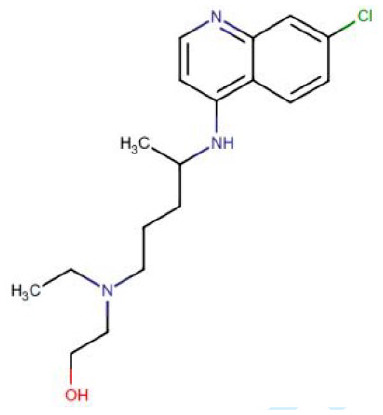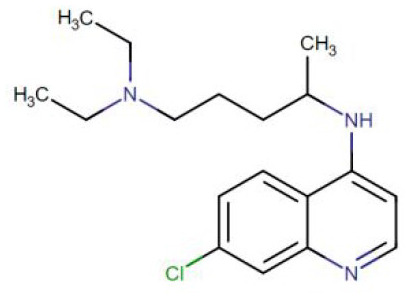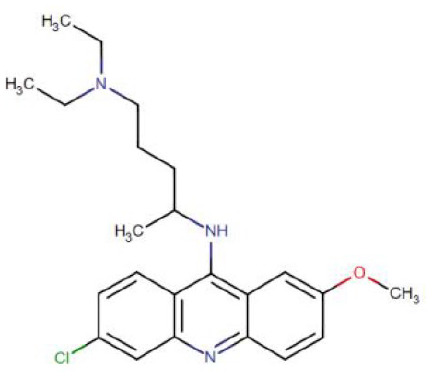Table 1.
Main pharmacodynamic properties of antimalarials.
| Hydroxychloroquine (HCQ) | Chloroquine (CQ) | Quinacrine | |
|---|---|---|---|
| Chemical structure |

|

|

|
| Chemical formula | C18H26ClN3O | C18H26ClN3 | C23H30ClN3O |
| Way of administration | Oral intake | ||
| Absorption | In upper intestinal tract after a 200 mg oral dose, HCQ reached a Cmax of 129.6 ng/ml with a Tmax of 3.26 h in the blood 18 |
In upper intestinal tract oral CQ reaches a Cmax of 65–128 µg/L with a Tmax of 0.5 h 19 |
In upper intestinal tract more details not available |
| Bioavailability | 67–74% 20 | 67–100% 19 | Not available |
| Volume of distribution | 5522 liters from blood and 44,257 liters from plasma 20 | 200–800 L/kg 19 | Not available |
| Protein binding | 50% 20 | 46–74% 21 | 80–90% 22 |
| Metabolism | In the liver, N-dealkylated by CYP3A4 to the active metabolite desethylhydroxychloroquine, as well as the inactive metabolites desethylchloroquine and bidesethylchloroquine17,18 | In the liver, N-dealkylated primarily by CYP2 C8 and CYP3A4 to N-desethylchloroquine N-dealkylated to a lesser extent by CYP3A5, CYP2D6, and to an ever lesser extent by CYP1A119 |
Not available |
| Elimination | 40–50% of HCQ is excreted renally, while only 16–21% of a dose is excreted in the urine as unchanged drug 5% of a dose is sloughed off in skin and 24–25% is eliminated through the feces19,20 |
Predominantly eliminated in the urine, renal excretion: 65–70%.
24
50% of a dose is recovered in the urine as unchanged CQ, with 10% of the dose recovered in the urine as desethylchloroquine 19 |
Less than 11% is eliminated in the urine daily 28 |
| Elimination half-life | Historically, 40–50 days (chronic use) A 200 mg oral dose of HCQ: 537 h to 50 days (blood) or 32 days or 123 days in plasma18,23 Maybe shorter, about 5 days, according to more recent studies25,26 |
6–60 days (mean of 20 days)19,24 | 5–14 days |
